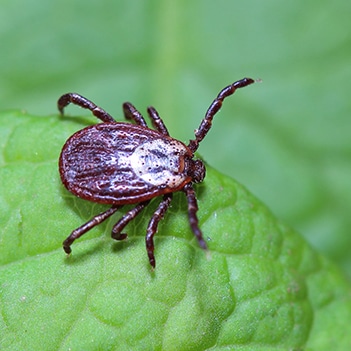Ticks Facts & Information
Prevent Pest Control is always reliable. Always innovative.
What You Should Know About Ticks
Ticks are small arachnids that have been around for millions of years, with fossil records dating back to the Cretaceous period. Among insects, the eight-legged tick has a closer relationship with spiders and mites. They get their sustenance from the blood of both people and animals since they are parasites from the outside world.
Many people in both rural and urban locations are worried about ticks because of the diseases they carry and the fact that they inhabit grassy, forested, or brush-covered places. They are known as persistent and dangerous pests in part because they can stay stuck to things and eat for lengthy periods of time.

Our Services
Expertise and Reliability
Mosquito Guid
Tick Guid
Bed Bug Guid
Flea Guid
Cockroach Guid
Yellow Jacket Guid
Carpenter Ant Guid
Rodent Guid
What Ticks Look Like and How They Grow
Ticks are little, oval-shaped insects whose bodies expand like balloons as they gorge themselves on blood. While they’re adults or nymphs, spiders have eight legs, but while they’re larvae, they only have six. The idiosoma is the main body of the insect, and the capitulum is the outer covering that protects the mouthparts. Ticks may range in color from brown to reddish-brown to black; however, species and feeding habits might affect tick coloration.
Because of their larger size and ability to expand considerably when engorged, adult females are sometimes mistaken for males. In many species, males eat less regularly or not at all; thus, they tend to be smaller and flatter.
Egg, larva, nymph, and adult are the four stages of a tick’s life cycle. As soon as they emerge from their cocoon, larvae begin their search for a host to consume before molting into nymphs. Before maturing into adults, nymphs eat as well. The whole life cycle of a tick may take anywhere from a few months to a few years, and most ticks need a new host at each stage.
What Makes Ticks Different from Other Insects
Ticks are uniquely adapted for parasitic survival. Because they lack the ability to fly or leap, they engage in a behavior known as “questing,” in which they perch on grass or bushes and wait for a passing host to grip onto their extended legs. While feeding for days on end, they are able to penetrate skin and attach themselves securely due to their unique mouthparts.
Ticks are able to feed covertly because their saliva has anesthetic and anticoagulant qualities. They detect vibrations, carbon dioxide, and heat to find hosts, and they can go without meals for lengthy periods of time, sometimes even a year. These traits make ticks highly efficient and persistent parasites.
Daily Routines and Living Habits of Ticks
While the majority of ticks do their work in the warmer months (spring and summer in particular), there are a few species that can survive in colder weather. They engage in questing behavior to attach to hosts rather than jumping or flying. Ticks may feed for up to ten days after attaching before they fall off. It is common for a female to deposit millions of eggs in a single batch in soil or leaf litter after consuming a blood meal.
When you’re outside, you can come across ticks in dense vegetation, along animal paths, and in tall grasses. They may be carried inside on people’s clothes or pets and can often be found hiding in crevices, under carpets, or in upholstery. Ticks are very sensitive to changes in humidity and prefer damp settings; they stay away from bright, dry places and are seldom seen in dry or well-lit places. The availability of hosts and other environmental factors impacts their reproductive cycles and mobility, which in turn affects their chances of survival.
How to Spot and Understand a Tick Infestation
Serious health risks may arise from a tick infestation because ticks can spread illnesses like Rocky Mountain spotted fever and Lyme disease. The presence of ticks inside, particularly on pets, bedding, or furniture, may be stressful and unpleasant, even though ticks don’t cause structural harm.
Ticks clinging to people or pets, crawling on surfaces after being outside, or tiny, black bugs in dark places like baseboards, carpet edges, or under furniture are common indicators. Pets may experience heightened itching or skin irritation as a result of an infestation. The key to reducing health concerns and future spread is early discovery and fast response.
How Ticks Can Affect Your Health and Safety
Ticks are known vectors of several serious illnesses that affect both humans and animals. A number of diseases may be spread by their bites, including Lyme disease, anaplasmosis, ehrlichiosis, and Rocky Mountain spotted fever. Ticks may transmit diseases like babesiosis and tick-borne encephalitis in specific areas.
Tick bites don’t always cause sickness, but when they do, you could experience things like a high temperature, lethargy, sore joints, skin rashes (like Lyme disease’s bullseye rash), and even swelling where the tick bit you. When exposed to certain allergens, some individuals may have mild to severe responses.
In very rare instances, a sugar molecule in tick saliva might create an allergy to red meat known as alpha-gal syndrome. Another factor that might raise the chance of infection is an extended period of attachment or bites that go unreported. It is crucial to be aware of symptoms and remove them promptly in order to minimize any health concerns.

Get a Free Quote Today!
"(Required)" indicates required fields
